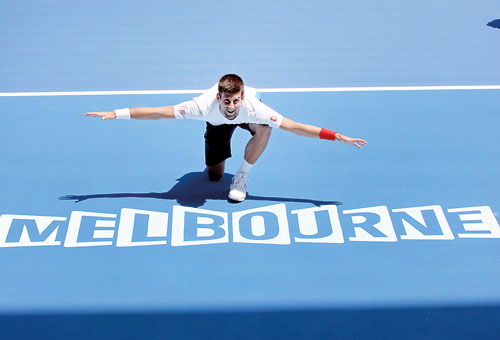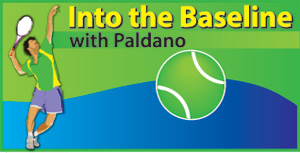Melbourne’s ‘AO’ is Australian-Open
View(s):The ‘Australian-Open’ has been branded with a stylized ‘A’ and a ‘O’. It was originally played on grass courts in Sydney, and moved to Melbourne only a few decades ago. In doing so, they also coupled the idea of having another type of Court, making the 4 Grand-Slams events to be played on four different surfaces.
 It was a good idea in terms of challenge, and it was also the time a school of thought emerged that, the game has become too fast on hard and grass courts and was losing its lustre. To repack Tennis with excitement, artistry and variety, extensive development-thinking went into it. I believe, Melbourne Park courts are about the 5th generation of Hard Tennis court surface in that direction.
It was a good idea in terms of challenge, and it was also the time a school of thought emerged that, the game has become too fast on hard and grass courts and was losing its lustre. To repack Tennis with excitement, artistry and variety, extensive development-thinking went into it. I believe, Melbourne Park courts are about the 5th generation of Hard Tennis court surface in that direction.
A common notion among players is that, Melbourne court surface has a tendency for the feet to get stuck when having to slide. The bounce too varies with temperature. Talking of temperature, it can be 40 degrees Celsius in summer. If there is one tournament to my memory that gave so many twisted ankles to players, it is the courts in Melbourne. In Melbourne, not only one has to play with different tactics, but also move different. I am sure all of them have their ankles strapped as a precaution.
A tactical bounce
In the matches one saw in the first three days of the 2017 Australian-Open, another peculiar occurrence repeated itself. I have never seen so many good players ‘miss hit’ so many times. Spain’s Vadasco lost to Federer easily. The number of shots from Verdasco, that did not connect well in that match, was way above the average. Then, it also happened to Andy Murray, Djokovic and a few other good players.
When Tennis players see a ball coming at them, they are fairly certain, after the 5-minute knock-up permitted before the match, as to what the bounce would be like and contact needed to play it back effectively. This surface did not provide that comfort zone to players. Somewhere behind the service line, the ball bounced different. For what reason, I do not know. The smarter ones are going to use this tactically.
Legendary court names
One of the surprising aspects of this year’s Australian-Open is the abruptness with which it comes to being, just three weeks into the annual season. I will not be wrong in saying that, so early in the tour, players are yet to feel the racquet in the hand. It being so, one can expect many upsets in the early rounds. That is loss of seeded players. In the very first round Romania’s Halep lost to USA’s Rogers and that was the biggest upset in the first day. All others have shown expected results. However, the 3rd Round of the Women’s and Men’s events will be a different story.
Two of the well known Tennis players who achieved the Grand-Slam, that is winning the Australian, French, Wimbledon and the US-Open titles in a calendar year, are Margaret Court and Rod Laver in the ’60s. Since then, Australian domination of Tennis could be termed ‘thin’. The two main stadium courts of the Melbourne Park Tennis complex are named after these two who made Australia a Tennis nation. To accommodate the heat, they have also placed a retractable cover. These state-of-the-art courts were packed from the very 1st Round.
The old repertoire
In any match, the winning side will sustain the game to wrap the win, and the losing side will have to venture into variations, trying to change the game. To do so, the players’ methods of development, play a major role. If a player is not developed for variation, she/he will have nothing to ‘change to’ when losing. Regretfully, even in this era, this seems to be common even at the highest level. Basically, all-court-players can change the game, and talking about it, only Roger Federer exhibited this ability in the Australian-Open up to now. Vadasco, against Djokovic, stuck to the Spanish repertoire and lost tamely.
 Out there, Tennis popularity is not on the rise, as it was a few decades ago. One of the aspects that create staleness in high-end sports is the repeats of the same style of tactics till the end by the losing side. It does not provide interest to the audience. New emerging sports which are many, do not have this disadvantage in presenting it. The older sports still go for gentleness, classical beauty and noble challenge. The newer sports are embracing other values which have better appeal among the younger sporting generation.
Out there, Tennis popularity is not on the rise, as it was a few decades ago. One of the aspects that create staleness in high-end sports is the repeats of the same style of tactics till the end by the losing side. It does not provide interest to the audience. New emerging sports which are many, do not have this disadvantage in presenting it. The older sports still go for gentleness, classical beauty and noble challenge. The newer sports are embracing other values which have better appeal among the younger sporting generation.
‘AO’ is Australian-Open
Events such as the Australian-Open cannot ignore audience interest anymore. To rejuvenate its Australian-Open spirit, it has come out with a Logo- ‘AO’. The organisers must be praying that the surviving players will provide enough strength to their new logo and make 2017 a memorable one. The logo is being stylized to look good, but only the quality of Tennis will make it memorable. Considering Tennis is to survive another 100 years, the responsibility falls heavily on the players and the direction in which Tennis will develop.
–George Paldano, Former intl. player; Accredited Coach of Germany; National, Davis-Cup, Federation Cup captain/coach– georgepaldano@yahoo.com


